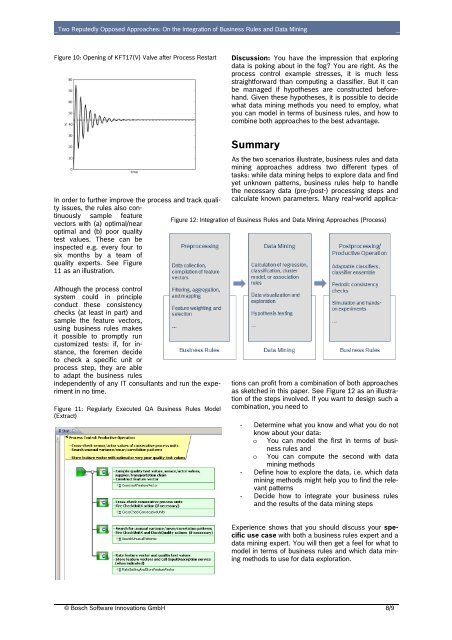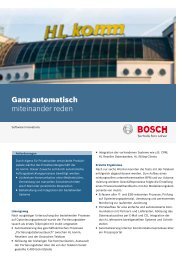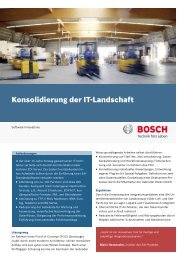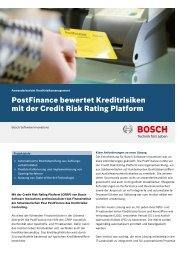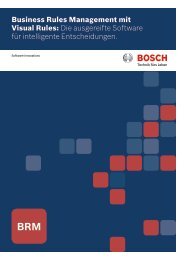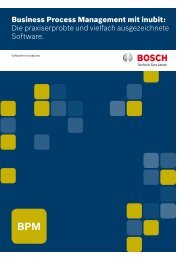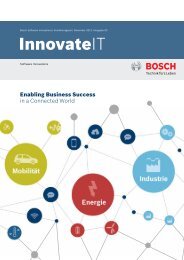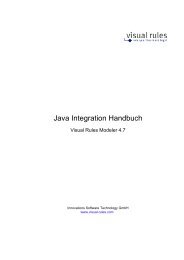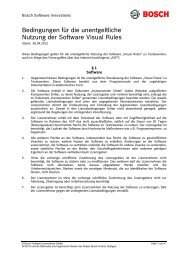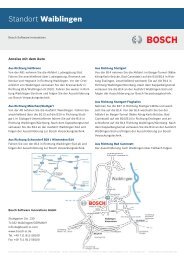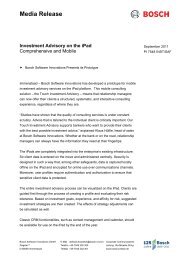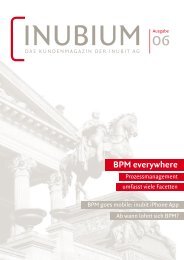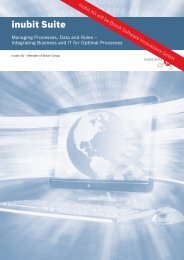Two Reputedly Opposed Approaches: On the Integration of ...
Two Reputedly Opposed Approaches: On the Integration of ...
Two Reputedly Opposed Approaches: On the Integration of ...
Create successful ePaper yourself
Turn your PDF publications into a flip-book with our unique Google optimized e-Paper software.
<strong>Two</strong> <strong>Reputedly</strong> <strong>Opposed</strong> <strong>Approaches</strong>: <strong>On</strong> <strong>the</strong> <strong>Integration</strong> <strong>of</strong> Business Rules and Data Mining<br />
Figure 10: Opening <strong>of</strong> KFT17(V) Valve after Process Restart<br />
In order to fur<strong>the</strong>r improve <strong>the</strong> process and track quality<br />
issues, <strong>the</strong> rules also continuously<br />
sample feature<br />
vectors with (a) optimal/near<br />
optimal and (b) poor quality<br />
test values. These can be<br />
inspected e.g. every four to<br />
six months by a team <strong>of</strong><br />
quality experts. See Figure<br />
11 as an illustration.<br />
Although <strong>the</strong> process control<br />
system could in principle<br />
conduct <strong>the</strong>se consistency<br />
checks (at least in part) and<br />
sample <strong>the</strong> feature vectors,<br />
using business rules makes<br />
it possible to promptly run<br />
customized tests: if, for instance,<br />
<strong>the</strong> foremen decide<br />
to check a specific unit or<br />
process step, <strong>the</strong>y are able<br />
to adapt <strong>the</strong> business rules<br />
independently <strong>of</strong> any IT consultants and run <strong>the</strong> experiment<br />
in no time.<br />
Figure 11: Regularly Executed QA Business Rules Model<br />
(Extract)<br />
Discussion: You have <strong>the</strong> impression that exploring<br />
data is poking about in <strong>the</strong> fog? You are right. As <strong>the</strong><br />
process control example stresses, it is much less<br />
straightforward than computing a classifier. But it can<br />
be managed if hypo<strong>the</strong>ses are constructed beforehand.<br />
Given <strong>the</strong>se hypo<strong>the</strong>ses, it is possible to decide<br />
what data mining methods you need to employ, what<br />
you can model in terms <strong>of</strong> business rules, and how to<br />
combine both approaches to <strong>the</strong> best advantage.<br />
Summary<br />
As <strong>the</strong> two scenarios illustrate, business rules and data<br />
mining approaches address two different types <strong>of</strong><br />
tasks: while data mining helps to explore data and find<br />
yet unknown patterns, business rules help to handle<br />
<strong>the</strong> necessary data (pre-/post-) processing steps and<br />
calculate known parameters. Many real-world applica-<br />
Figure 12: <strong>Integration</strong> <strong>of</strong> Business Rules and Data Mining <strong>Approaches</strong> (Process)<br />
tions can pr<strong>of</strong>it from a combination <strong>of</strong> both approaches<br />
as sketched in this paper. See Figure 12 as an illustration<br />
<strong>of</strong> <strong>the</strong> steps involved. If you want to design such a<br />
combination, you need to<br />
- Determine what you know and what you do not<br />
know about your data:<br />
o You can model <strong>the</strong> first in terms <strong>of</strong> business<br />
rules and<br />
o You can compute <strong>the</strong> second with data<br />
mining methods<br />
- Define how to explore <strong>the</strong> data, i.e. which data<br />
mining methods might help you to find <strong>the</strong> relevant<br />
patterns<br />
- Decide how to integrate your business rules<br />
and <strong>the</strong> results <strong>of</strong> <strong>the</strong> data mining steps<br />
Experience shows that you should discuss your specific<br />
use case with both a business rules expert and a<br />
data mining expert. You will <strong>the</strong>n get a feel for what to<br />
model in terms <strong>of</strong> business rules and which data mining<br />
methods to use for data exploration.<br />
© Bosch S<strong>of</strong>tware Innovations GmbH 8/9


